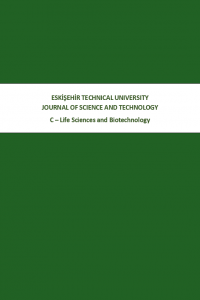BAZI YENİ KİNOKSALİN HİDRAZONLARIN SENTEZİ ve ANTİMİKROBİYAL AKTİVİTELERİ
10 yeni kinoksalin hidrazondan oluşan yeni bir grup aktimikrobiyal aktivitesi incelenmek üzere sentezlenmiştir. Bileşiklerin yapıları IR, 1H-NMR, MS spektral ve elemental analiz ile aydınlatılmıştır. Bileşiklerin antimikrobiyal aktiviteleri Mikro-broth dilüsyon yöntemi ile 3 fungus ve 7 bakteri türüne karşı değerlendirilmiştir. Sentezlenen bütün bileşikler Pseudomonas aeruginosa’ ya karşı önemli antibakteriyal aktivite göstermiştir. Ayrıca, 2,4-difloro yapısı içeren 4b bileşiği Pseudomonas aeruginosa’ ya karşı kloramfenikolden 2 kat daha iyi antibakteriyal aktivite göstermiştir
Anahtar Kelimeler:
Kinoksalin, Hidrazon, Antimikrobiyal aktivite, Mikro-broth dilüsyon
SYNTHESIS and ANTIMICROBIAL ACTIVITY of SOME NOVEL QUINOXALINE HYDRAZONES
A new class of 10 novel quinoxaline hydrazones was synthesized to examine their antimicrobial activity. The structural of the compounds was confirmed by IR, 1H-NMR, and MS spectral data and elemental analyses. Antimicrobial activity of the compounds was evaluated against 3 fungal and 7 bacterial strains by Micro-broth dilution assay. All of the synthesized compounds indicated showed significant antibacterial activity against Pseudomonas aeruginosa. Furthermore, antibacterial activity of the 2,4-difluoro substituted compound 4b displayed two fold better activity than chloramphenicol against this bacterial strain.
Keywords:
Quinoxaline Hydrazone, Antimicrobial activity, Micro-broth dilution, Pseudomonas aeruginosa,
___
- Akhand, S.S., Pettit, R.S., Gardner, T.E., Anderson, G.G. (2014). New treatments in development for Pseudomonas aeruginosa Infections in the Lungs of Individuals with Cystic Fibrosis. Orphan Drugs Research and Reviews 4.
- Backes, G.L., Neumann, D.M., Jursic, B.S. (2014). Synthesis and Antifungal Activity of Substituted Salicylaldehyde Hydrazones, Hydrazides and Sulfohydrazides. Bioorganic & Medicinal Chemistry 22(17), 4629–4636.
- Becker, I. (2008). Preparation of derivatives of 1-(2-pyrimidinyl) Piperazine as Potential Antianxiety, Antidepressant, and Antipsychotic Agents. Journal of Heterocyclic Chemistry 45: 1005-1022.
- Carta, A., Paglietti, G., Nikookar, M.E.R., Sanna, P., Sechi, L., Zanetti, S. (2002). Novel Substituted Quinoxaline 1,4-dioxides with in vitro Antimycobacterial and Anticandidal Activity. European Journal of Medicinal Chemistry 37(5), 355–366.
- Chen, C.Y., Lin, T.P., Chen, C.K., Lin, S.C., Tseng, M.C., Wen, Y.S., Sun, S.S. (2008). New Chromogenic and Fluorescent Probes for Anion Detection: Formation of a [2+2] Supramolecular Complex on Addition of Fluoride with Positive Homotropic Cooperativity. Journal of Organic Chemistry 73(3), 900-911.
- CLSI. Methods for Dilution Antimicrobial Susceptibility Tests for Bacteria That Grow Aerobically Approved Standard, CLSI Document M7-A7, seventhed. (2006). ISBN1-56238-587-9.
- El-Faham, A., El-Massry, A.M., Amer, A., Gohar, Y.M. (2002). A Versatile Synthetic Route to Chiral Quinoxaline Derivatives from Aminoacids Precursors. Letters Peptide Science 9(1), 49–54.
- El-Sabbagh, OI., El-Sadek, M.E., Lashine, S.M., Yassin, S.H., El-Nabtity, S.M. (2009). Synthesis of new 2(1H)-Quinoxalinone Derivativesfor Antimicrobial and Antiinflammatory Evaluation. Medicinal Chemistry Research 18(9), 782–797.
- Ishikawa, H., Sugiyama, T., Kurita, K., Yokoyama, A. (2012). Synthesis and Antimicrobial Activity of 2,3Bis(bromomethyl)quinoxaline Derivatives. Bioorganic Chemistry 41:1–5.
- Ishikawa, H., Sugiyama, T., Yokoyama, A. (2013). Synthesis of 2,3bis(halomethyl)quinoxaline Derivatives and Evaluation of Their Antibacterial and Antifungal Activities. Chemical and Pharmaceutical Bulletin 61(4), 438–444.
- Kamal, A., Babu, K.S., Faazil, S., Ali Hussaini, S.M., Shaik, A.B. (2014). L-Proline Mediated Synthesis of Quinoxalines; Evaluation of Cytotoxic and Antimicrobial Activity. Royal Society of Chemistry 4(86), 46369–46377.
- Khaksar, S., Tajbakhsh, M., Gholami, M., Rostamnezhad, F.A. (2014). Highly efficient Procedure for the Synthesis of Quinoxaline Derivatives using Polyvinylpolypyrrolidone Supported Triflic Acid Catalyst. Chinese Chemical Letters 25(9), 1287–1290.
- Khan, J., Wahab, A., Qayyum, A., Jamshed, S. (2014). Drug Resistance Pattern of Pseudomonas aeruginosa isolates at PIMS Hospital. Journal of Chemical and Pharmaceutical Research 6(11), 715-719.
- Kotharkar, S.A., Shinde, D.B. (2006). Synthesis of antimicrobial 2,9,10-trisubstituted-6-oxo7,12-dihydro-chromeno[3,4-b]quinoxalines. Bioorganic & Medicinal Chemistry Letters 16(24), 6181–6184.
- Nagaraj, K., Ambika, S., Arunachalam, S. (2015). Synthesis, CMC Determination, and Intercalativebinding Interaction with Nucleic Acid of Asurfactant–copper(II) complex with Modified Phenanthroline Ligand (dpq). Journal of Biomolecular Structure and Dynamics 33(2), 274-288.
- Narasimhan, B., Kumar, P., Sharma, D. (2010). Biological Activities of Hydrazide Derivatives in the New Millennium. Acta Pharmaceutica Sciencia 52:169-180.
- Poole, K. (2014). Stress Responses as Determinants of Antimicrobial Resistance in Pseudomonas aeruginosa: Multidrug Efflux and More. Canadian Journal of Microbiology 60:783-791.
- Ramalingam, P., Ganapaty, S., Rao, C.B. (2010). In vitro Antitubercular and Antimicrobial Activities of 1-Substituted Quinoxaline-2,3(1H,4H)-diones. Bioorganic & Medicinal Chemistry Letters 20(1), 406– 408.
- Sıngh, D.C.P., Hashım, S.R., Sınghal R.G. (2011). Synthesis and Antimicrobial Activity of Some New Thioether Derivatives of Quinoxaline. E-Journal of Chemistry 8(2), 635-642.
- Soliman, A.M., Amer, A.A. (2012). Synthesis and Antimicrobial Activity of Some Novel Quinoxalines. Synthetic Communications 42(10), 1401–1410.
- Ulbrich, K., Subr, V. (2004). Polymeric Anticancer Drugs with pH-controlled Activation. Advanced Drug Delivery Reviews, 56(7), 1023-1050.
- Veerappa, K., Babu, Y., Siddanakatte, D. (2014). The Influence of Imipenem Resistant Metallo-Beta-Lactamase Positive and Negative Pseudomonas aeruginosa Nosocomial Infections on Mortality and Morbidity. Journal of Natural Science Biology & Medicine 5(2), 345-351.
- Vieira, M., Pinheiro, C., Fernandes, R., Noronha, J.P., Prudencio, C. (2014). Antimicrobial Activity of Quinoxaline 1,4Dioxide with 2- and 3-substituted Derivatives. Microbiol Research 169(4), 287– 293.
- Yan-Yan, H. (2010). An Efficient Synthesis of 3-(indol-3-yl)quinoxalin-2-ones with TfOHCatalyzed Friedel–Crafts Type Coupling Reaction in Air. Tetrahedron Letters 51(15), 2023-2028.
- Yurttaş, L., Özkay, Y., Karaca, H., Tunalı, Y., Kaplancıklı. Z.A. (2013). Synthesis and Antimicrobial Evaluation of Some 2,5Disubstituted Benzimidazole Derivatives. Letters in Drug Design & Discovery 10(6), 486-491.
- Wayne, P.A. (2008). CLSI document M27-A3, Clinical and Laboratory Standards Institute.
- Wu, J., Wang, J., Hu, D., He, M., Jin, L., Song, B. (2012). Synthesis and Antifungal Activity of Novel Pyrazolecarboxamide Derivatives Containing Hydrazone Moiety. Chemistry Central Journal 6:51.
- Zhang, M., Dai, Z.C., Qian, S.S., Liu, J.Y., Xiao, Y., Lu, A.M., Zhu, H.L., Wang, J.X., Ye, Y.H. (2014). Design, Synthesis, Antifungal, and Antioxidant Activities of (e‑6-((2Phenylhydrazono)methyl)quinoxaline Derivatives. Journal of Agricultural and Food Chemistry 62(40), 9637−9643.
- ISSN: 2667-4203
- Yayın Aralığı: Yılda 2 Sayı
- Başlangıç: 2010
- Yayıncı: Eskişehir Teknik Üniversitesi
Sayıdaki Diğer Makaleler
STACHYS RUPESTRIS (LAMIACEAE)’İN UÇUCU YAĞ BİLEŞİMİ VE ANTİMİKROBİYAL ETKİLERİ
GÖKALP İŞCAN, Yavuz KÖSE, Betül DEMİRCİ
CITRUS RETICULATA BLANCO UÇUCU YAĞININ KİMYASAL BİLEŞİMİ
BAZI YENİ KİNOKSALİN HİDRAZONLARIN SENTEZİ ve ANTİMİKROBİYAL AKTİVİTELERİ
Esra BAŞYİĞİT, Ulviye ACAR ÇEVİK, Yusuf ÖZKAY, Hülya KARACA GENÇER, Ümit UÇUCU
ESKİŞEHİR SCARABAEOIDEA FAUNASINA KATKILAR
Yakup ŞENYÜZ, Kemal DİNDAR, Mehmet GÜLMEZ
Mehlika Dilek ALTINTOP, Belgin SEVER, Ahmet ÖZDEMİR, Zafer Asım KAPLANCIKLI
